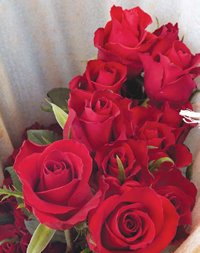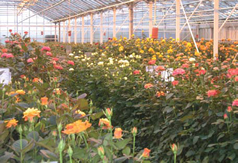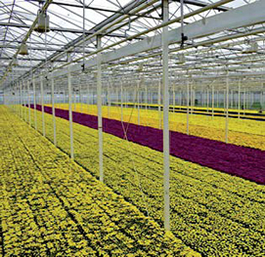Featured Past Articles
February 14th is upon us. It is Valentine’s Day; a day marked by lovers, friends and family to show affection by swapping such presents as flowers, cards, chocolates and other expressive, if not romantic gifts
 But first, the ever fascinating Valentine’s story
But first, the ever fascinating Valentine’s story
There exists several tales about the origin of Valentine’s Day, and nobody knows if they are factual. The most famous ones all have endings. The first one is about the young Valentine, who was a victim of his belief on February 14 of the year 270. He, a Roman, converted to Christianity and by doing so offended the Roman leaders. On February 14 Valentine was tortured and beheaded. However, he succeeded in giving the daughter of the prison warder a note just before he died. The note contained the legendary text ‘From your Valentine; forever marking february the 14th as a day of love displays.
Another story is about a priest in Rome named Valentine. An emperor named Claudius II had forbidden the Roman soldiers to marry, because he was of the opinion that unmarried men were better soldiers. Priest Valentine ignored this rule and united young couples into marriage. The emperor found out about this and imprisoned Valentine and sentenced him to death.
It is all Red
The big rush is over. In the weeks leading up to February 14th, growers worked around the clock to harvest and ship their flowers, and at the beginning of the week, the final Valentine’s flowers left the farm. Also at the FloraHolland auction in Rijnsburg and Aalsmeer, the same trend happened. “The overall picture this year was moderate to good”, says Amerik de Best, auctioneer at Rijnsburg. “In general, the quality was good and red received good prices at Rijnsburg. White was also doing quite well, but other colours trailed behind.”
Read more: Chequered Bloom:Rose Growers Reflect on Valentine’s Day
 Luckily, consumers are starting to request more information on where and how their flowers were grown and who grew them. Most of the Kenyan growers welcome this paradigm shift.
Luckily, consumers are starting to request more information on where and how their flowers were grown and who grew them. Most of the Kenyan growers welcome this paradigm shift.
Kenyan growers encourage transparency not only in their business, but in the entire floral industry. “We aim to be stewards of the earth and work in harmony with nature to create amazing cut flowers that are safe for farmers to grow, and promote healthy soil”, says Andrew Wambua as he prepared for 2019 Valentine.
So, how do we highlight to our customers that we are a sustainable farm dedicated to the economic, social, and environmental well-being of our land, our flowers, our team members, and our community?
The way that makes the most sense for the growers, has been to obtain certification to Sustainable Agriculture Standard. This trusted certification quickly signals to consumers that our flowers were grown in a responsible, ethical and sustainable manner.
 As Britain prepares to leave the European Union, workers in Kenya’s flower industry are closely monitoring developments. Flowers are big business in Kenya and earnings from exports have doubled in the past five years. A key export destination is the UK, which most of the flowers enter after being auctioned in the Netherlands. Growers and exporters in Kenya are asking the same question - what impact will Brexit have on the flower trade?
As Britain prepares to leave the European Union, workers in Kenya’s flower industry are closely monitoring developments. Flowers are big business in Kenya and earnings from exports have doubled in the past five years. A key export destination is the UK, which most of the flowers enter after being auctioned in the Netherlands. Growers and exporters in Kenya are asking the same question - what impact will Brexit have on the flower trade?
What is the current situation?
Kenyan flower exporters currently enjoy zero tariffs on cut flowers sold to the EU. This is set by an interim arrangement, which Kenya secured through signing and ratifying the Economic Partnership Agreement between the EU and the East African Community.
The deal is temporary until the three other members in the regional group sign up so it can come into full effect.
Why does the UK flower trade matter to Kenya?
Britain is the second largest export destination for Kenya’s cut flowers after the Netherlands, taking almost 18% of the flowers produced in the country.
In recent years, the Russian government has made self-sufficiency a top priority. This has already resulted in a large number of new greenhouse projects for vegetable cultivation. But also in flowers and plants, Russia aims to become less dependent on imports. That’s not all bad news for foreign companies, however. The expansion of domestic growers opens up opportunities for suppliers from other countries, while Russia’s increasingly affluent population drives up demand for flowers and plants, both from within the country and abroad.
 It’s not just vegetable greenhouses that are popping up across the country - Russian ornamental growers are doing good business too, expanding for the sake of self-sufficiency. For instance, a new greenhouse in Saint Petersburg is to meet up to 60% of the city’s demand in flowers for flowerbeds. A few months later, in June 2018, construction of a tulip greenhouse near Smolensk was announced. Other recent expansions include a rose greenhouse in North Ossetia, while a rose grower near Moscow just announced a 6 hectare expansion.
It’s not just vegetable greenhouses that are popping up across the country - Russian ornamental growers are doing good business too, expanding for the sake of self-sufficiency. For instance, a new greenhouse in Saint Petersburg is to meet up to 60% of the city’s demand in flowers for flowerbeds. A few months later, in June 2018, construction of a tulip greenhouse near Smolensk was announced. Other recent expansions include a rose greenhouse in North Ossetia, while a rose grower near Moscow just announced a 6 hectare expansion.
These are just a few examples that show how the flower business in Russia is stabilizing - a development also noticed by the organizers of the annual FlowersExpo, who are seeing an increasing number of domestic participants.
Opportunities for suppliers
These expansions offer chances for suppliers. One such supplier, Schneider, is seeing constant growth in the Russian market. As Zsófia Simó, marketing & communication specialist at the company,said: “Russian growers always strive to expand their businesses and Schneider youngplants is happy to provide valuable knowledge and advice in order to allow them to reach their goals.”
This sentiment was echoed on the trade show floor, where it became apparent that several growers were expanding or planning to expand their greenhouses. In turn, the breeders at the show also reported seeing an increasing interest for their varieties from the Russian growers.
Read more: Plenty of Market Opportunities Russia: A Nation of Flower Lovers
Most consumers do not think ordinarily about the origin of the cut flowers they purchase. Though many people are informed, conscious consumers who do know to hunt for eco-friendly products for many aspects of their lives such as food, beverages, and body care, when it comes to the flowers at the center of their dinner table, they often don’t consider sustainability. Markets
Kenya is desperately trying to comply with new demands imposed by Australia to ensure the country’s cut flowers continue to access the fast growing market. Early this year, Australia introduced new requirements that all flowers exported to the country be fumigated at the country of origin as part of new biosecurity rules. Before the new regulations, exporters were undertaking the fumigation process in Australia.
Although the rules introduced on March 1 were to take effect in August, the Kenyan government managed to negotiate for an extension and got a deadline of December. “Australia’s new rule that every exporter fumigates flowers at source is a big challenge for Kenyan growers and exporters because we do not have fumigation facilities,” said Nehemiah Chepkwony, Horticulture Crops Directorate interim head.
Deadline
With the deadline fast looming and amidst efforts by Kenya’s ambassador in Australia to seek an extension of the grace period, the country is frantically racing against time to install the necessary facility to ensure the country continues to access the Australian market.
The Horticulture Directorate has already issued permits to three private companies to invest in the facilities, one of which is SGS Kenya. The company is setting up a facility at the Jomo Kenyatta International Airport.
The other firms are Vegpro Group and Panalpina Kenya Ltd. “We are hoping to have the facilities ready in the next two months to enable exporters comply with the requirement because the Australian market in important for Kenya,” said Mr Chepkwony. Being the leading flower exporter to Australia, Kenya cannot afford to lose the market that has been on a growth trajectory with exports averaging 30 tonnes per month.
Indeed a partnership between Kenya Airways and Australia’s Qantas Airways has significantly boosted the exports due to the creation of an efficient supply chain that makes it easy to reach key cities like Sydney and Melbourne. Official data by Australia’s Federal Department of Agriculture shows that in 2017 Kenya exported cut flowers worth $16.2 million to Australia followed by countries like Malaysia ($12 million), Colombia ($9.1 million), and Ecuador ($9.1 million).
In February this year alone, Australia imported 5.22 million rose stems from Kenya, up from 4.37 million stems in the same period last year.
Lack of information sharing among the players in the fresh produce value chain has been identified as a key set back in the industry, degrading its potential in the agricultural industry. From farmers, transporters, cold storage chain providers and exporters, the silence along the chain is said to be a costly scenario with calls for data sharing and information exchange to unlock the industry’s potential that is now gathering pace.
At a recent logistics conference held in Nairobi, the perishable goods dealers agreed to create a seamless information sharing that would ensure their operations are run according to plan and minimise wastage occasioned by poor information flow.
Lufthansa Cargo Global Industry Manager, Agriculture and Fresh, Wouter Boekee said lack of information sharing has been a key logistic headache for the airline in planning for the peak season for various fresh produces whose logistic needs vary.
“We find it hard for example to tell what volumes of which fresh produce we should expect from one region in different seasons. When we have either under planned or over planned, either players end up at a loss,” said Mr Boekee who was among the panellists at the conference. “Information sharing is a critical conversation we must start having for an efficient flow of business in this industry.”
The losses include wastage when the cargo reaches the airport and has to wait for cargo space to be available to export them, as well as an empty cargo provision when the products are under-delivered by the farmers and exporters.
The conference organised by the Flower Logistics Africa (FLA) on and Perishable Logistics Africa (PLA) also heard that the lack of a proper fresh produce database with accurate production projections has caused a deficiency in cold storage facilities investments, creating massive losses for the products.
Cold storage facilities, which is a capitalintensive venture, would require accurate data to help potential investor project the rate of return on the investments and to avoid falling into the loss trap with under supply or missed business opportunities when the fresh produce volumes surpass their installations capacity.
“We are almost left firefighting all the time because we are handling fresh products with very strict standards prescribed by the international market. I agree with the fact that we need to share information so that we also understand other market dynamics like what is expected to be in supply in different periods,” said Miyonga Fresh Greens founder Yvonne Otieno.
The Kenya Plant Health Inspectorate Service (Kephis), which assist fresh produce dealers understand the different phytosanitary standards countries set for their products, also said there is need to establish a proper information exchange among players including the regulator to enable it play its role in facilitating the fresh produce trade.
Kephis general manager for Phytosanitary Services Dr Isaac Macharia said the regulator will continue to give the required support for the fresh produce dealers in issuing plant passports which are mandatory for any plant crossing borders. “Every trader must have a plant passport to move their produce and we at Kephis would equally benefit from such data to enable us prepare to provide the passports to the fresh produce dealers. This an industry where planning is key and information drives the planning process,” Dr Macharia said.
Horticulture exports, which earned the country some Sh104 billion in the first eight months of 2018 due to proper rainfall, is expected to earn more with the direct flights between Nairobi and New York. A recent deal with China is also expected to open more market for cut flower dealers who have traditionally relied on a single economic bloc, the European Union, exposing them to trade vulnerabilities.
Most Kenyan flower reach China through the Netherlandsbased international flower auction.
At the China International Import Expo, flowers becomes an important exhibit and decoration in the Kenya Pavilion. Fourth Largest Fresh Cut Flower Exporter The geographical advantage of Lake Naivasha in Kenya is suitable for roses’ growth. The roses have a strong competitive edge in international flower market! In Kenya, the flower industry has become an important pillar of Kenyan economy after tourism and tea. As the world’s fourth largest exporter of fresh cut flowers, Kenya’s flower industry is mainly served for the European market, and nearly half of it is sold to the world through the Dutch auction market.
New Favorite for China’s Consumers
In recent years, the flower consumption has risen so fast that domestic supply has been unable to match the demand. The increasing consumption gives rise to the sales of high-quality imported flowers. Kenyan flowers, as medium and high-end variety in China, have become the new favorite in suppliers and consumers.


